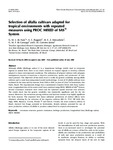Use este identificador para citar ou linkar para este item:
http://www.alice.cnptia.embrapa.br/alice/handle/doc/631709Registro completo de metadados
| Campo DC | Valor | Idioma |
|---|---|---|
| dc.contributor.author | ASSIS, G. M. L. de | pt_BR |
| dc.contributor.author | RUGGIERI, A. C. | pt_BR |
| dc.contributor.author | MERCADANTE, M. E. Z. | pt_BR |
| dc.contributor.author | CAMARGO, G. M. F. de | pt_BR |
| dc.contributor.author | CARNEIRO JUNIOR, J. M. | pt_BR |
| dc.date.accessioned | 2011-04-10T11:11:11Z | pt_BR |
| dc.date.available | 2011-04-10T11:11:11Z | pt_BR |
| dc.date.created | 2010-01-29 | pt_BR |
| dc.date.issued | 2009 | pt_BR |
| dc.identifier.citation | Plant Genetic Resources, United Kingdom, v. 8, n.1, p. 55-62, Apr. 2009. | pt_BR |
| dc.identifier.issn | 1479-2621 (impresso) | pt_BR |
| dc.identifier.uri | http://www.alice.cnptia.embrapa.br/alice/handle/doc/631709 | pt_BR |
| dc.description | Although alfalfa (Medicago sativa L.) is a leguminous herbage widely used in temperate regions as animal feed, there is not much research in tropical regions to develop cultivars adapted to these environmental conditions. The utilization of adapted cultivars with adequate management practices is important to improve productivity, quality and persistence of cultivated pastures. The objectives of this study were to verify the genetic variability among alfalfa cultivars and to rank them using mixed model methodology. A total of 35 alfalfa cultivars were evaluated in the rainy and dry seasons, from 1996 to 2000, in plots of 2.8 m2 in Sertãozinho, São Paulo, Brazil. The experimental design was a randomized complete block with three replications. Longitudinal data of dry matter yield were analyzed using PROC MIXED of SAS® System. Several covariance structures were tested and the spherical spatial structure was selected. The results show that the genetic variability was statistically significant only for the dry season. Moreover, the interaction among cultivars and harvests variance was highly significant for both seasons. The empirical best linear unbiased predictions of cultivar effects were obtained, allowing for the selection of the superior cultivars MH 15, 5715, SW 8210, Rio, High, 5888, Monarca, Victoria, Florida 77 and Falcon. Crioula, the most common cultivar in Brazil, showed low forage potential in Sertãozinho. Results indicate potential for use of more productive cultivars of alfalfa to produce animal feed in tropical environments. | pt_BR |
| dc.language.iso | eng | eng |
| dc.rights | openAccess | eng |
| dc.subject | PROC MIXED | pt_BR |
| dc.subject | SAS system | pt_BR |
| dc.subject | Anális estatística | pt_BR |
| dc.subject | Análisis estadístico | pt_BR |
| dc.subject | Fitomejoramiento | pt_BR |
| dc.subject | Leguminosas forrajeras | pt_BR |
| dc.subject | Trópicos | pt_BR |
| dc.subject | Variación genética | pt_BR |
| dc.title | Selection of alfafa cultivars adapted for tropical environments with repeated measures using PROC MIXED of SAS system. | pt_BR |
| dc.type | Artigo de periódico | pt_BR |
| dc.date.updated | 2019-01-09T11:11:11Z | pt_BR |
| dc.subject.thesagro | Melhoramento genético vegetal | pt_BR |
| dc.subject.thesagro | Leguminosa forrageira | pt_BR |
| dc.subject.thesagro | Alfafa | pt_BR |
| dc.subject.thesagro | Medicago sativa | pt_BR |
| dc.subject.thesagro | Variação genética | pt_BR |
| dc.subject.thesagro | Variedade resistente | pt_BR |
| dc.subject.thesagro | Clima tropical | pt_BR |
| dc.subject.thesagro | Método estatístico | pt_BR |
| dc.subject.nalthesaurus | Alfalfa | pt_BR |
| dc.subject.nalthesaurus | Plant breeding | pt_BR |
| dc.subject.nalthesaurus | Forage legumes | pt_BR |
| dc.subject.nalthesaurus | Genetic variation | pt_BR |
| dc.subject.nalthesaurus | Tropics | pt_BR |
| dc.subject.nalthesaurus | Statistical analysis | pt_BR |
| riaa.ainfo.id | 631709 | pt_BR |
| riaa.ainfo.lastupdate | 2019-01-09 -02:00:00 | pt_BR |
| dc.identifier.doi | 10.1017/S1479262109990153. | pt_BR |
| dc.contributor.institution | GISELLE MARIANO LESSA DE ASSIS, CPAF-AC; UNESP; Instituto de Ciência Animal, SP; UNESP; JOSE MARQUES CARNEIRO JUNIOR, CPAF-AC. | pt_BR |
| Aparece nas coleções: | Artigo em periódico indexado (CPAF-AC)  | |
Arquivos associados a este item:
| Arquivo | Descrição | Tamanho | Formato | |
|---|---|---|---|---|
| 22647.pdf | 163.98 kB | Adobe PDF |  Visualizar/Abrir |









